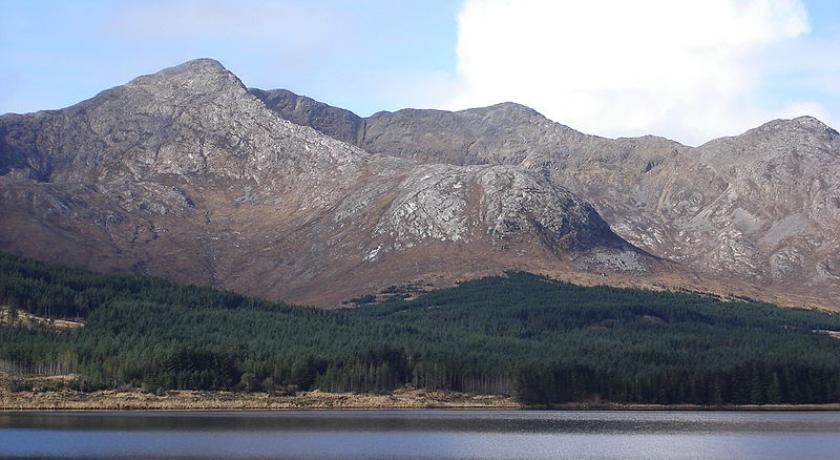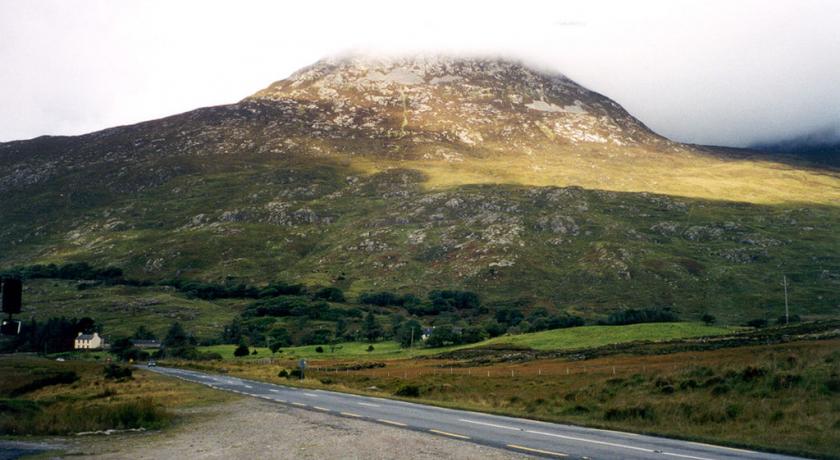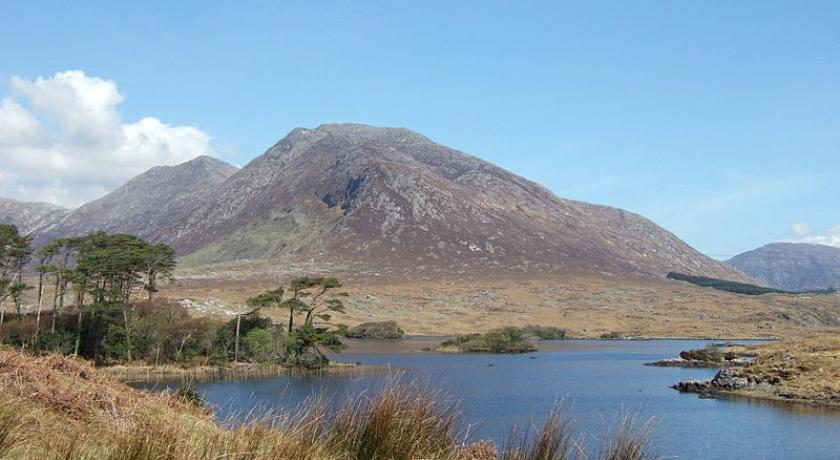Description
Connemara (Irish: Conamara; pronounced [ˈkɔnˠamˠaɾˠa]) is a cultural region in County Galway, Ireland. The area has a strong association with traditional Irish culture and contains a vast part of the Connacht Irish-speaking Gaeltacht, which is a key part of the identity of the region and is the largest Gaeltacht in the country.
The most common definition of the area is that it consists of West Galway; that is to say the part of the county west of Lough Corrib, contained by Killary Harbour, Galway Bay and the Atlantic Ocean. More restrictive definitions of Connemara define it as the historical territory of Conmhaícne Mara; just the far northwest of County Galway, bordering County Mayo. The wider area of what is today known as Connemara was previously a sovereign kingdom known as Iar Connacht, under the kingship of the Ó Flaithbertaigh, until it became part of the Kingdom of Ireland in the 16th century.
Overview
The term Connemara is the northern area of County Galway west of Lough Corrib. It is also used to describe the Gaeltacht (Irish-speaking areas) of western County Galway, though it is argued that this too is inaccurate as some of these areas lie outside of the traditional boundary of Connemara. Some argue that it is not correct to say that Connemara's eastern boundary ends around Barna just on the outskirts of Galway City or at Maam Cross.
Etymology
"Connemara" derives from the tribal name Conmacne Mara, which designated a branch of the Conmacne, an early tribal grouping that had a number of branches located in different parts of Connacht. Since this particular branch of the Conmacne lived by the sea, they became known as the Conmacne Mara (sea in Irish is muir, genitive mara, hence "of the sea"). The area in the east of what is now Connemara was called Delbhna Tír Dhá Locha.
Geography
The coast of Connemara is made up of multiple peninsulas. The peninsula of Iorras Ainbhtheach (sometimes corrupted to Iorras Aithneach) in the south is the largest and contains the villages of Carna and Kilkieran. The peninsula of Errismore consists of the area west of the village of Ballyconneely. Errisbeg peninsula lies to the south of the village of Roundstone. The Errislannan peninsula lies just south of the town of Clifden. The peninsulas of Kingstown, Coolacloy, Aughrus, Cleggan and Renvyle are found in the north-west of Connemara. Of the numerous islands off the coast of Connemara, Inishbofin is the largest; other islands include Omey, Inishark, High Island, Friars Island, Feenish and Maínis.
Connemara lies in the territory of Iar Connacht, "West Connacht", which is the portion of County Galway west of Lough Corrib. Connemara was traditionally divided into North Connemara and South Connemara. The mountains of the Twelve Bens and the Owenglin River, which flows into the sea at An Clochán/Clifden, marked the boundary between the two parts. Connemara is bounded on the west, south and north by the Atlantic Ocean. Connemara's land boundary with the rest of County Galway is marked by the Invermore River otherwise known as Inbhear Mór (which flows into the north of Kilkieran Bay), Loch Oorid (which lies a few miles west of Maam Cross) and the western spine of the Maumturks mountains. In the north of the mountains, the boundary meets the sea at Killary, a few miles west of Leenaun.
Connemara is composed of the Catholic parishes of Carna, Clifden (Omey and Ballindoon), Ballynakill, Roundstone and Inishbofin. The territory contains the civil parishes of Moyrus, Ballynakill, Omey, Ballindoon and Inishbofin (the last parish was for a time part of the territory of the Clann Uí Mháille, the O Malleys of the territory of Umhall, County Mayo).
History
The Ó Cadhla (Kealy) clan were the rulers of Connemara up until the 13th century, when they were displaced by the Ó Flaithbertaighs. The latter had fled into Iar Connacht from Maigh Seola during the English invasion of Connacht in the early 13th century.
Like the Ó Cadhla clan, the Mac Conghaile (Conneely) clan was also a branch of the Conmhaicne Mara.
The main town of Connemara is Clifden. The area around the town is rich with megalithic tombs. The famous "Connemara Green marble" is found outcropping along a line between Streamstown and Lissoughter. It was a trade treasure used by the inhabitants of the prehistoric time. It continues to be of great value today. It is available in large dimensional slabs suitable for buildings as well as for smaller pieces of jewellery. It is used for the pendant for the Scouting Ireland Chief Scout's Award, the highest award in Irish Scouting.
The first transatlantic flight, piloted by Alcock and Brown, landed in Clifden in 1919.
Transport
Connemara is accessible by the Bus Éireann and City Link bus services. From 1895 to 1935 it was served by the Midland Great Western Railway branch that connected Galway City to Clifden. The railway line is still visible on the N59.
A popular alternative route is the coastal route on the R336 from Galway City. This route is also known as the Connemara Loop consisting of a 45 km drive where one can view the landscape and scenery of Connemara.
Aer Arann Islands serves the Aran Islands from Connemara Airport in the south of Connemara also known as Aerfort na Minna.
Irish language
The population of Connemara is 32,000. There are between 20,000-24,000 native Irish speakers in the region making it the largest Irish-speaking Gaeltacht.
The Enumeration Districts with the most Irish speakers in all of Ireland as a percentage of the population can be seen in the South Connemara area.
Most Irish speakers are of school age (5–19 years old).
Notable towns and villages
- Barna - (Bearna)
- Ballyconneely - (Baile Conaola / Baile Mhic Chonghaile)
- Ballynahinch - (Baile na hInse)
- Carna - (Cárna)
- Carraroe - (An Cheathrú Rua)
- Claddaghduff - (An Cladach Dubh)
- Cleggan - (An Cloigeann)
- Clifden - (An Clochán)
- Inverin - (Indreabhán)
- Kilkerren - (Cill Chiaráin)
- Leenaun - (An Lionán / Leenane)
- Letterfrack - (Leitir Fraic)
- Lettermore - (Leitir Móir)
- Lettermullen - (Leitir Mealláin)
- Maum - (An Mám , also 'Maam')
- Oughterard - (Uachtar Ard )
- Recess - (Sraith Salach)
- Renvyle - (Rinn Mhaoile)
- Rosmuc - (Ros Muc)
- Rossaveal – (Ros an Mhíl)
- Roundstone - (Cloch na Rón)
- Spiddal - (An Spidéal)
Notable islands
- Omey Island - (Iomaidh)
- Inishbofin - (Inis Bó Finne) has been home to fishermen, farmers, exiled monks and fugitive pirates for over 6,000 years and today the island supports a population of 200 full-time residents.
Curiosities
- French singer Michel Sardou had an international hit with the song "Les Lacs du Connemara" in 1981.
- The Irish drinking song "The Hills of Connemara" has been recorded and performed by a number of Irish and Celtic-themed bands.
- Poet Carl Sandburg's home of 22 years in Flat Rock, North Carolina, which is now a national monument, is named after the Connemara region.
- Conamara Chaos is a region of chaotic terrain on Jupiter's moon Europa.
- The Connemara pony is a breed of horse native to the region.
- Connemara is also the name of a brand of Irish whiskey produced at the Cooley Distillery.
Annalistic references
- 807. A slaughter was made of the Conmaicni by the foreigners.
Notable people associated with Connemara
- John Ford, the American film director, and winner of 4 Academy Awards, whose real name was Sean O'Feeney, was the son of John Augustine Feeney from Spiddal, and directed the classic film The Quiet Man in nearby Cong, County Mayo.
- Máire Geoghegan-Quinn is an Irish politician, and was the former European Commissioner for Research, Innovation and Science was born in Carna.
- Richard Martin, MP, known as "Humanity Dick", was born in Ballynahinch Castle, Ballynahinch and represented Galway in the House of Commons.
- Michael Morris, 3rd Baron Killanin, was president of the International Olympic Committee (IOC), and lived at the family seat in Spiddal.
- Patrick Nee, Irish-born American mobster in South Boston, member of the Mullen Gang and associate of Irish American mobster Whitey Bulger.
- Máirtín Ó Cadhain was one of the most prominent Irish language writers of the 20th century, and wrote the Irish language classic Cré na Cille, was born in Connemara.
- Peter O'Toole, the noted actor of stage and screen, who achieved stardom in 1962 playing T.E. Lawrence in Lawrence of Arabia, was born in Connemara in 1932, according to accounts of his life.
- Pádraig Pearse who was one of the leaders of the Easter Rising in 1916, owned a cottage in Rosmuc, where he spent his summers learning the Irish language and writing.
- Maharaja Jam Sahib of Nawanagar, an Indian prince and cricket player, was the first head of state to make an official visit to the newly founded Irish Free State, bought Ballynahinch Castle estate and visited the area every year till his death in 1932.
- Tim Robinson, a cartographer, has lived many years in Connemara and published books on the area.
- Gráinne Seoige, the Irish TV presenter and journalist, who has worked for TG4, RTÉ, SKY and the BBC, is a native of Spiddal.
- Mairtin Thornton was a heavyweight boxer, nicknamed the "Connemara Chrusher", he was the Irish Heavyweight boxing champion in 1943, and fought Bruce Woodcock for the British heavyweight title in 1945.
- Ludwig Wittgenstein, an Austrian philosopher, was a temporary resident, for some months in 1948, at Rosroe on Killary Harbour.
- Lord Ismay, Chairman of the White Star Line, which owned the Titanic, lived for part of his later life in his lodge in Connemara. Ismay was on board the Titanic when it sunk but was one of the survivors.
- Sean Mannion, a professional boxer who boxed out of Massachusetts and fought for the WBA, was born in Rosmuc.
Source: https://en.wikipedia.org/wiki/Connemara
Address
Connemara
Ireland
Lat: 53.248867035 - Lng: -9.201055527






